France 法国饮食 英文版
- 格式:ppt
- 大小:4.48 MB
- 文档页数:28
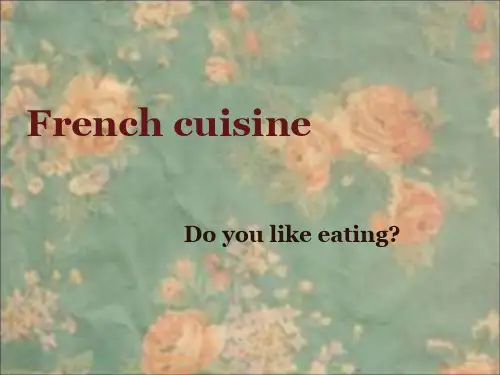

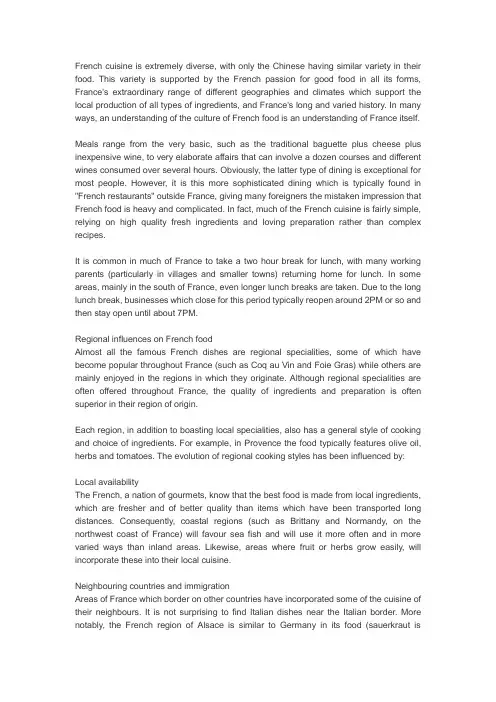
French cuisine is extremely diverse, with only the Chinese having similar variety in their food. This variety is supported by the French passion for good food in all its forms, France's extraordinary range of different geographies and climates which support the local production of all types of ingredients, and France's long and varied history. In many ways, an understanding of the culture of French food is an understanding of France itself.Meals range from the very basic, such as the traditional baguette plus cheese plus inexpensive wine, to very elaborate affairs that can involve a dozen courses and different wines consumed over several hours. Obviously, the latter type of dining is exceptional for most people. However, it is this more sophisticated dining which is typically found in "French restaurants" outside France, giving many foreigners the mistaken impression that French food is heavy and complicated. In fact, much of the French cuisine is fairly simple, relying on high quality fresh ingredients and loving preparation rather than complex recipes.It is common in much of France to take a two hour break for lunch, with many working parents (particularly in villages and smaller towns) returning home for lunch. In some areas, mainly in the south of France, even longer lunch breaks are taken. Due to the long lunch break, businesses which close for this period typically reopen around 2PM or so and then stay open until about 7PM.Regional influences on French foodAlmost all the famous French dishes are regional specialities, some of which have become popular throughout France (such as Coq au Vin and Foie Gras) while others are mainly enjoyed in the regions in which they originate. Although regional specialities are often offered throughout France, the quality of ingredients and preparation is often superior in their region of origin.Each region, in addition to boasting local specialities, also has a general style of cooking and choice of ingredients. For example, in Provence the food typically features olive oil, herbs and tomatoes. The evolution of regional cooking styles has been influenced by:Local availabilityThe French, a nation of gourmets, know that the best food is made from local ingredients, which are fresher and of better quality than items which have been transported long distances. Consequently, coastal regions (such as Brittany and Normandy, on the northwest coast of France) will favour sea fish and will use it more often and in more varied ways than inland areas. Likewise, areas where fruit or herbs grow easily, will incorporate these into their local cuisine.Neighbouring countries and immigrationAreas of France which border on other countries have incorporated some of the cuisine of their neighbours. It is not surprising to find Italian dishes near the Italian border. More notably, the French region of Alsace is similar to Germany in its food (sauerkraut ispopular) and wine, partly due to it currently bordering on Germany and partly due to it having been part of Germany at various points in its history (the border has moved back and forth with various wars). In parts of the south which have a large North African immigrant population one can enjoy the cuisine which they have imported from their original countries.History and economic conditionsThe culture, lifestyle and economic conditions over a long period of time have formed the development of local food traditions. The rich meat dishes and cream sauces of Burgundy are not only due to Burgundian excellence in raising cattle, but in large part to the economic prosperity of this region over several centuries. On the other hand, mountain regions excel in firm cheeses, which allow food to be preserved over the long and difficult winters, and can be produced from mountain livestock which historically were the main means of support for many families in economically limited areas.In all parts of France one will find a range of dishes, both in restaurants and in homes, which extends far beyond the regional specialities. However, in much of France the regional influences in terms of ingredients and cooking are marked. The most available food and the best cooking tend to be those produced from local ingredients and using local recipes. Therefore, the decision of where to visit or live in France tends to influence which types of food one will enjoy.The French Mediterranean uses olive oil, herbs and tomatoes in many of its dishes. The cuisine of northwest France uses butter, soured cream (crème fraiche) and apples. The cuisine of northeast France (Alsace, and to a lesser extent Lorraine) has a strong German influence which includes beer and sauerkraut. Throughout the south in general there tends to be more use of vegetables and fruit (in part due to the favourable climate). Near the Atlantic coast and the Mediterranean there is a greater consumption of sea food, while inland areas favoured by rivers (e.g. the Loire valley) use more fresh water fish.The Italian connectionAny discussion of the influences on French cuisine would be incomplete without recognising the historical contribution of Italy to the development of French cooking. In 1533, Catherine De Medicis (a Florentine princess) married Henry duc d'Orleans (who became King Henry II or France). At this point, France was not know for its food or food culture. Catherine brought an entourage of Italian chefs with her to France, who introduced to France a variety of dishes, food preparation and dining practices. Although France and Italy obviously have evolved very different food cultures, both before and since this contribution, much of France's current food culture can be traced back to this time.Cooking stylesEvery region of France has its own distinctive traditions in terms of ingredients and preparation (see France Regions for further information). On top of this, there are threegeneral approaches which compete with each other:Classical French cuisine (also known in France as cuisine bourgeoise).This includes all the classical French dishes which were at one time regional, but are no longer specifically regional. Food is rich and filling, with many dishes using cream-based sauces.Haute cuisineIt is classical French cuisine taken to its most sophisticated and extreme. Food is elegant, elaborate and generally rich. Meals tend to be heavy, especially due to the use of cream and either large portions or many smaller portions. There is a strong emphasis on presentation (in particular, vegetables tend to be cut with compulsive precision and uniformity). The finest ingredients are used, and the meal is correspondingly expensive.Cuisine Nouvelle.This style developed in the 1970s, as a reaction against the classical school of cooking. The food is simpler and lighter. Portions are smaller and less rich; the heavy cream sauces of the classical approach are particularly avoided. Cooking is less elaborate and quicker, with more emphasis on local and seasonal ingredients.Cuisine du terroir.This focuses on regional specialities and is somewhat more rustic in nature. Local produce and food traditions are the main focus.Each of these three traditions are strongly represented in France, with each having its supporters and specialist restaurants. At the moment, Cuisine Nouvelle is less popular than it was, while Cuisine du terroir has grown in popularity in recent years.Wine and cheeseAside from bread and water, the most common accompaniments to a French meal are wine and cheese. Unlike other countries, in France wine is considered a standard part of everyday meals, and is neither expensive nor reserved for special occasions. With everyday meals, ordinary wines are served, although it is expected that the style of wine match the style of food.In addition to its use in cooking, cheese is often served as a course in itself. In this case, it is served after the main meal but before dessert. This typically consists of a platter with three or four different cheeses, from which guests can slice pieces according to their preferences. Sliced bread (e.g. slices of a baguette) are typically provided at the same time.Restaurant guidesThe most famous and successful restaurant guide in France is the Michelin Guide Rouge, which has approximately 50% market share. It has enormous influence; the award of asingle star by the Guide Rouge to a restaurant can add 25% to its turnover and the loss of a star can mean financial ruin for a restaurant.The Guide Rouge is both a restaurant guide and a hotel guide, although its better known for the former. For the towns in the Guide Rouge there is a list of the main tourist attractions and for the larger towns there is a map. In addition to having one in the house it is handy to have one in the car (e.g. if you are unexpectedly delayed on a journey and need to find a good local restaurant).Although the Guide Rouge does not provide exact details on the criteria they use for rating restaurants, there are a number of factors beside the quality of food: service, atmosphere and value are some of the other considerations. This perhaps explains our experience that not all restaurants with the same overall rating have the same quality of food, one restaurant may have tremendous atmosphere and average food while another with the same rating may have exceptional food but little atmosphere. The Guide Rouge sometimes makes a few comments under a recommended restaurant; these are worth reading as they give an indication of what aspect of the restaurant impressed the reviewer. The comments sometimes note specialities of the house, which are often the best items on the menu.参考译文:法国的美食是非常多样的,只有中国有与之匹敌的食品种类。
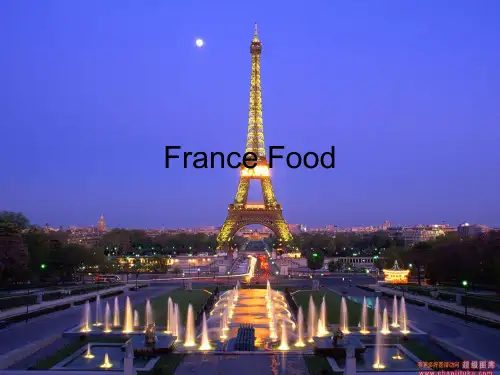
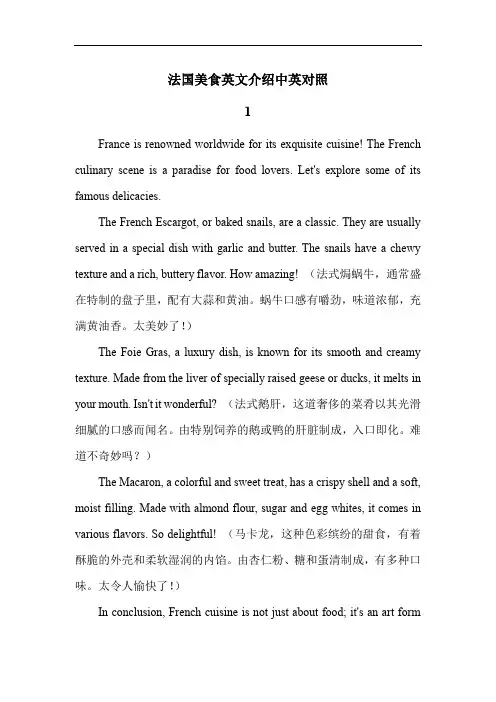
法国美食英文介绍中英对照1France is renowned worldwide for its exquisite cuisine! The French culinary scene is a paradise for food lovers. Let's explore some of its famous delicacies.The French Escargot, or baked snails, are a classic. They are usually served in a special dish with garlic and butter. The snails have a chewy texture and a rich, buttery flavor. How amazing! (法式焗蜗牛,通常盛在特制的盘子里,配有大蒜和黄油。
蜗牛口感有嚼劲,味道浓郁,充满黄油香。
太美妙了!)The Foie Gras, a luxury dish, is known for its smooth and creamy texture. Made from the liver of specially raised geese or ducks, it melts in your mouth. Isn't it wonderful? ((法式鹅肝,这道奢侈的菜肴以其光滑细腻的口感而闻名。
由特别饲养的鹅或鸭的肝脏制成,入口即化。
难道不奇妙吗?)The Macaron, a colorful and sweet treat, has a crispy shell and a soft, moist filling. Made with almond flour, sugar and egg whites, it comes in various flavors. So delightful! (马卡龙,这种色彩缤纷的甜食,有着酥脆的外壳和柔软湿润的内馅。
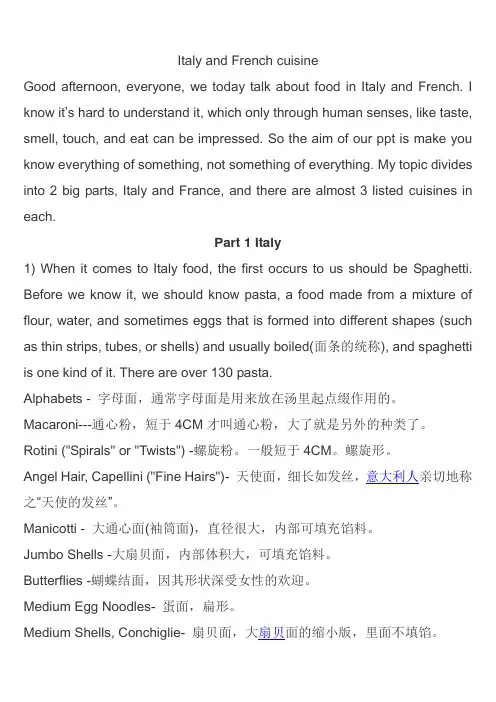
Italy and French cuisineGood afternoon, everyone, we today talk about food in Italy and French. I know it’s hard to understand it, which only through human senses, like taste, smell, touch, and eat can be impressed. So the aim of our ppt is make you know everything of something, not something of everything. My topic divides into 2 big parts, Italy and France, and there are almost 3 listed cuisines in each.Part 1 Italy1) When it comes to Italy food, the first occurs to us should be Spaghetti. Before we know it, we should know pasta, a food made from a mixture of flour, water, and sometimes eggs that is formed into different shapes (such as thin strips, tubes, or shells) and usually boiled(面条的统称), and spaghetti is one kind of it. There are over 130 pasta.Alphabets - 字母面,通常字母面是用来放在汤里起点缀作用的。
Macaroni---通心粉,短于4CM才叫通心粉,大了就是另外的种类了。
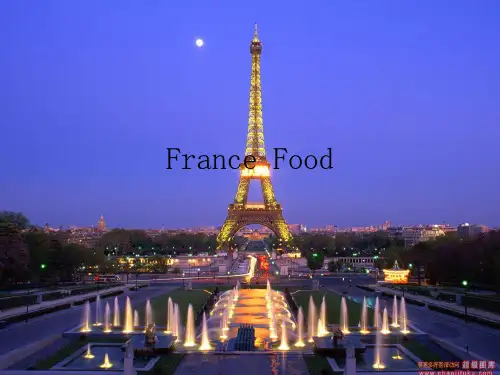
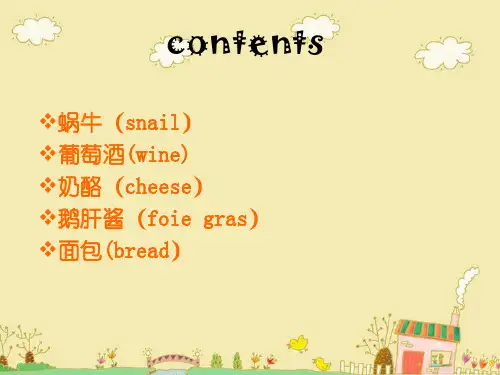
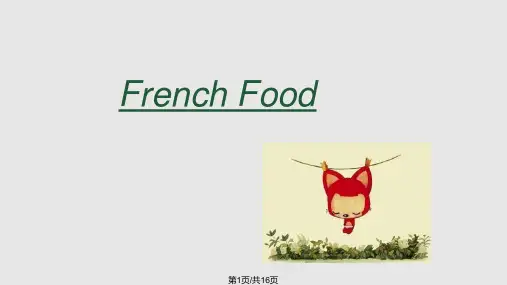

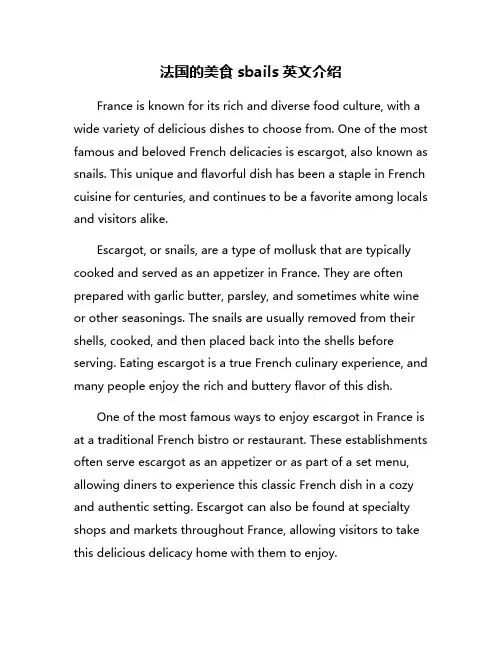
法国的美食sbails英文介绍France is known for its rich and diverse food culture, with a wide variety of delicious dishes to choose from. One of the most famous and beloved French delicacies is escargot, also known as snails. This unique and flavorful dish has been a staple in French cuisine for centuries, and continues to be a favorite among locals and visitors alike.Escargot, or snails, are a type of mollusk that are typically cooked and served as an appetizer in France. They are often prepared with garlic butter, parsley, and sometimes white wine or other seasonings. The snails are usually removed from their shells, cooked, and then placed back into the shells before serving. Eating escargot is a true French culinary experience, and many people enjoy the rich and buttery flavor of this dish.One of the most famous ways to enjoy escargot in France is at a traditional French bistro or restaurant. These establishments often serve escargot as an appetizer or as part of a set menu, allowing diners to experience this classic French dish in a cozy and authentic setting. Escargot can also be found at specialty shops and markets throughout France, allowing visitors to take this delicious delicacy home with them to enjoy.In addition to being delicious, escargot is also a healthy and sustainable food choice. Snails are low in fat and calories, and are a good source of protein and vitamins. They are also easy to farm and harvest, making them a more environmentally friendly option compared to other meats. This combination of taste, health benefits, and sustainability has made escargot a popular food choice in France and beyond.Overall, escargot is a true French culinary classic that continues to be enjoyed by people around the world. Its rich and buttery flavor, unique texture, and cultural significance make it a must-try dish for anyone visiting France. Whether you are a fan of adventurous eating or simply looking to experience the best of French cuisine, escargot is sure to delight your taste buds and leave you craving more. So next time you find yourself in France, be sure to give escargot a try – you won't be disappointed!。
有关法国食物的英语外刊The culinary heritage of France is a rich tapestry woven with flavors and traditions that have been passed down through generations. From the buttery pastries of Paris to the hearty stews of Provence, French cuisine is a testament to the country's diverse regional influences.Bread is a staple in French dining, with the baguette being the most iconic. Its crisp crust and soft interior make it a versatile companion to a variety of dishes, from a simple cheese platter to a hearty bowl of soup.No discussion of French food is complete without mentioning cheese. With over a thousand varieties, French cheese is celebrated for its diversity, ranging from the pungent Roquefort to the creamy Brie. Each region boasts its own unique cheese, reflecting the terroir and local culture.The art of French cooking is not just about the ingredients but also about the techniques. The classic French sauces, such as béchamel, hollandaise, and tomato, are the foundation of many French dishes, showcasing the balance of flavors and the skill of the chef.Desserts in France are a symphony of sweetness and indulgence. The delicate macaron, the rich crème brûlée, and the flaky mille-feuille are just a few examples of the pastry chef's artistry, each bite a celebration of the Frenchlove for the finer things in life.Wine is an integral part of the French dining experience. With vineyards stretching across the country, France produces a wide range of wines that are often paired with specific dishes to enhance the flavors and create a harmonious dining experience.Dining in France is an affair that extends beyond the meal itself. It is a social event where conversation flows as freely as the wine, and the enjoyment of food is as much about the company as it is about the flavors on the plate.In conclusion, French cuisine is a culinary journey that invites you to explore the country's history, culture, and passion for gastronomy. Each dish tells a story, and every meal is an opportunity to savor the essence of France.。
介绍法国的食品英语作文Title: A Culinary Journey Through France。
France, a country renowned for its rich culinary heritage, offers a gastronomic experience like no other. From the bustling markets of Paris to the quaint villages of Provence, every corner of France boasts its own unique flavors and delicacies. In this essay, we will embark on a culinary journey through France, exploring its diverse food culture and iconic dishes.Let's start our journey in Paris, the heart of French gastronomy. The city is home to an array of iconic dishes, from crispy croissants and buttery pain au chocolat to savory coq au vin and decadent foie gras. One cannot visit Paris without indulging in a traditional French onion soup, topped with gooey melted cheese and served in a crusty bread bowl. For dessert, nothing beats the classic French éclair, filled with creamy custard and topped with glossy chocolate glaze.Venturing southward to the sunny region of Provence, we encounter a bounty of fresh produce and vibrant flavors. Provencal cuisine is characterized by its use of aromatic herbs such as thyme, rosemary, and lavender, which infuse dishes with a distinct Mediterranean flair. One cannot miss sampling ratatouille, a hearty vegetable stew bursting with summer flavors, or bouillabaisse, a fragrant seafood soup brimming with the catch of the day. And of course, no visit to Provence is complete without savoring a slice of tarte tropézienne, a luscious cream-filled pastry named after the glamorous town of Saint-Tropez.Continuing our journey to the southwest, we arrive in the gastronomic capital of Lyon. Lyon is famed for its bouchons, cozy bistros serving up traditional Lyonnaise fare. Here, one can indulge in indulgent dishes such as quenelles de brochet, light and airy fish dumplings smothered in creamy sauce, or andouillette, a robust sausage made from tripe and offal. For dessert, a slice of praline tart is a must, showcasing the region's love affair with caramelized nuts and buttery pastry.No culinary tour of France would be complete without a visit to the wine regions that dot the countryside. From the rolling vineyards of Bordeaux to the sun-drenched slopes of Burgundy, France produces some of the world's finest wines. Sample a glass of Bordeaux's bold reds or Burgundy's elegant whites, paired perfectly with local cheeses such as creamy brie or tangy Roquefort.In conclusion, France's food culture is as diverse and vibrant as the country itself. From the bustling markets of Paris to the quaint villages of Provence, each regionoffers its own culinary delights and gastronomic treasures. Whether savoring a buttery croissant in a Parisian café or indulging in a hearty cassoulet in the French countryside, a culinary journey through France is sure to tantalize the taste buds and leave a lasting impression. Bon appéti t!。
法国美食作文英语French Cuisine: A Culinary DelightFrench cuisine is renowned worldwide for its rich flavors, exquisite presentation, and culinary artistry. It is a symbol of sophistication and elegance, reflecting the culture and history of France. French food is celebrated for its diversity, from delicate pastries to hearty dishes. Here is an overview of some key aspects of French cuisine.1. Classic Dishes:French cuisine boasts a variety of classic dishes that are loved globally. One such dish is **Coq au Vin**, a hearty stew made with chicken braised in red wine, mushrooms, onions, and bacon. Another popular dish is **Bouillabaisse**, a traditional fish stew from the region of Provence, known for its complex flavors and aromatic herbs. **Ratatouille** is another staple, a vegetable medley from the south of France that highlights the freshness of seasonal produce.2. Bread and Pastries:French bread and pastries are iconic and a central part of French culinary tradition. The **Baguette**, with its crispy crust and soft interior, is a staple at every French meal. **Croissants** and **Pain au Chocolat** are beloved breakfast items, enjoyed for their flaky texture and rich taste. **Macarons**, with their colorful shells and delicate filling, are a quintessential French treat, often found in patisseries across the country.3. Cheese:France is famous for its cheese, with over 400 varieties to choose from. **Camembert**, a soft and creamy cheese from Normandy, and **Roquefort**, a blue cheese from the south, are just a few examples. French cheese is often enjoyed with bread or paired with wine, and each region has its own specialties and traditions regarding cheese production.**4. Wine:**French wine is celebrated for its quality andvariety. The country’s wine regions, including Bordeaux, Burgundy, and Champagne, produce some of the world’s finest wines. **Bordeaux** wines are known for their rich reds, while **Champagne** is famous for its sparkling wines. Wine is an integral part of French meals, often enjoyed with cheese, meats, and other dishes.5. Culinary Techniques:French cuisine is renowned for its cooking techniques, which have influenced culinary practices worldwide. Techniques such as **sautéing**,**braising**, and **sous-vide** (a method of cooking food in a vacuum-sealed bag) are central to French cooking. The precision and attention to detail in French culinary arts are reflected in the intricate preparations and presentation of dishes.6. Desserts:French desserts are known for their indulgence and artistry. **Crème Brûlée**, with its creamy custard base and caramelized sugar crust, is a classic favorite.**Tarte Tatin**, an upside-down caramelized apple tart, is another beloved dessert. French pastries like**Éclairs** and **Madeleines** also highlight the country’s expertise in creating delicious sweet treats.Conclusion:French cuisine is a celebration of flavors, traditions, and culinary skill. From the classic dishes that represent the heart of French cooking to the delicate pastries and world-renowned cheeses, French food offers a delightful experience for the senses. It reflects the rich cultural heritage of France and continues to inspire and delight food lovers around the world.。
French cuisine is extremely diverse, with only the Chinese having similar variety in their food. This variety is supported by the French passion for good food in all its forms, France's extraordinary range of different geographies and climates which support the local production of all types of ingredients, and France's long and varied history. In many ways, an understanding of the culture of French food is an understanding of France itself.Meals range from the very basic, such as the traditional baguette plus cheese plus inexpensive wine, to very elaborate affairs that can involve a dozen courses and different wines consumed over several hours. Obviously, the latter type of dining is exceptional for most people. However, it is this more sophisticated dining which is typically found in "French restaurants" outside France, giving many foreigners the mistaken impression that French food is heavy and complicated. In fact, much of the French cuisine is fairly simple, relying on high quality fresh ingredients and loving preparation rather than complex recipes.It is common in much of France to take a two hour break for lunch, with many working parents (particularly in villages and smaller towns) returning home for lunch. In some areas, mainly in the south of France, even longer lunch breaks are taken. Due to the long lunch break, businesses which close for this period typically reopen around 2PM or so and then stay open until about 7PM.Regional influences on French foodAlmost all the famous French dishes are regional specialities, some of which have become popular throughout France (such as Coq au Vin and Foie Gras) while others are mainly enjoyed in the regions in which they originate. Although regional specialities are often offered throughout France, the quality of ingredients and preparation is often superior in their region of origin.Each region, in addition to boasting local specialities, also has a general style of cooking and choice of ingredients. For example, in Provence the food typically features olive oil, herbs and tomatoes. The evolution of regional cooking styles has been influenced by:Local availabilityThe French, a nation of gourmets, know that the best food is made from local ingredients, which are fresher and of better quality than items which have been transported long distances. Consequently, coastal regions (such as Brittany and Normandy, on the northwest coast of France) will favour sea fish and will use it more often and in more varied ways than inland areas. Likewise, areas where fruit or herbs grow easily, will incorporate these into their local cuisine.Neighbouring countries and immigrationAreas of France which border on other countries have incorporated some of the cuisine of their neighbours. It is not surprising to find Italian dishes near the Italian border. More notably, the French region of Alsace is similar to Germany in its food (sauerkraut ispopular) and wine, partly due to it currently bordering on Germany and partly due to it having been part of Germany at various points in its history (the border has moved back and forth with various wars). In parts of the south which have a large North African immigrant population one can enjoy the cuisine which they have imported from their original countries.History and economic conditionsThe culture, lifestyle and economic conditions over a long period of time have formed the development of local food traditions. The rich meat dishes and cream sauces of Burgundy are not only due to Burgundian excellence in raising cattle, but in large part to the economic prosperity of this region over several centuries. On the other hand, mountain regions excel in firm cheeses, which allow food to be preserved over the long and difficult winters, and can be produced from mountain livestock which historically were the main means of support for many families in economically limited areas.In all parts of France one will find a range of dishes, both in restaurants and in homes, which extends far beyond the regional specialities. However, in much of France the regional influences in terms of ingredients and cooking are marked. The most available food and the best cooking tend to be those produced from local ingredients and using local recipes. Therefore, the decision of where to visit or live in France tends to influence which types of food one will enjoy.The French Mediterranean uses olive oil, herbs and tomatoes in many of its dishes. The cuisine of northwest France uses butter, soured cream (crème fraiche) and apples. The cuisine of northeast France (Alsace, and to a lesser extent Lorraine) has a strong German influence which includes beer and sauerkraut. Throughout the south in general there tends to be more use of vegetables and fruit (in part due to the favourable climate). Near the Atlantic coast and the Mediterranean there is a greater consumption of sea food, while inland areas favoured by rivers (e.g. the Loire valley) use more fresh water fish.The Italian connectionAny discussion of the influences on French cuisine would be incomplete without recognising the historical contribution of Italy to the development of French cooking. In 1533, Catherine De Medicis (a Florentine princess) married Henry duc d'Orleans (who became King Henry II or France). At this point, France was not know for its food or food culture. Catherine brought an entourage of Italian chefs with her to France, who introduced to France a variety of dishes, food preparation and dining practices. Although France and Italy obviously have evolved very different food cultures, both before and since this contribution, much of France's current food culture can be traced back to this time.Cooking stylesEvery region of France has its own distinctive traditions in terms of ingredients and preparation (see France Regions for further information). On top of this, there are threegeneral approaches which compete with each other:Classical French cuisine (also known in France as cuisine bourgeoise).This includes all the classical French dishes which were at one time regional, but are no longer specifically regional. Food is rich and filling, with many dishes using cream-based sauces.Haute cuisineIt is classical French cuisine taken to its most sophisticated and extreme. Food is elegant, elaborate and generally rich. Meals tend to be heavy, especially due to the use of cream and either large portions or many smaller portions. There is a strong emphasis on presentation (in particular, vegetables tend to be cut with compulsive precision and uniformity). The finest ingredients are used, and the meal is correspondingly expensive.Cuisine Nouvelle.This style developed in the 1970s, as a reaction against the classical school of cooking. The food is simpler and lighter. Portions are smaller and less rich; the heavy cream sauces of the classical approach are particularly avoided. Cooking is less elaborate and quicker, with more emphasis on local and seasonal ingredients.Cuisine du terroir.This focuses on regional specialities and is somewhat more rustic in nature. Local produce and food traditions are the main focus.Each of these three traditions are strongly represented in France, with each having its supporters and specialist restaurants. At the moment, Cuisine Nouvelle is less popular than it was, while Cuisine du terroir has grown in popularity in recent years.Wine and cheeseAside from bread and water, the most common accompaniments to a French meal are wine and cheese. Unlike other countries, in France wine is considered a standard part of everyday meals, and is neither expensive nor reserved for special occasions. With everyday meals, ordinary wines are served, although it is expected that the style of wine match the style of food.In addition to its use in cooking, cheese is often served as a course in itself. In this case, it is served after the main meal but before dessert. This typically consists of a platter with three or four different cheeses, from which guests can slice pieces according to their preferences. Sliced bread (e.g. slices of a baguette) are typically provided at the same time.Restaurant guidesThe most famous and successful restaurant guide in France is the Michelin Guide Rouge, which has approximately 50% market share. It has enormous influence; the award of asingle star by the Guide Rouge to a restaurant can add 25% to its turnover and the loss of a star can mean financial ruin for a restaurant.The Guide Rouge is both a restaurant guide and a hotel guide, although its better known for the former. For the towns in the Guide Rouge there is a list of the main tourist attractions and for the larger towns there is a map. In addition to having one in the house it is handy to have one in the car (e.g. if you are unexpectedly delayed on a journey and need to find a good local restaurant).Although the Guide Rouge does not provide exact details on the criteria they use for rating restaurants, there are a number of factors beside the quality of food: service, atmosphere and value are some of the other considerations. This perhaps explains our experience that not all restaurants with the same overall rating have the same quality of food, one restaurant may have tremendous atmosphere and average food while another with the same rating may have exceptional food but little atmosphere. The Guide Rouge sometimes makes a few comments under a recommended restaurant; these are worth reading as they give an indication of what aspect of the restaurant impressed the reviewer. The comments sometimes note specialities of the house, which are often the best items on the menu.参考译文:法国的美食是非常多样的,只有中国有与之匹敌的食品种类。